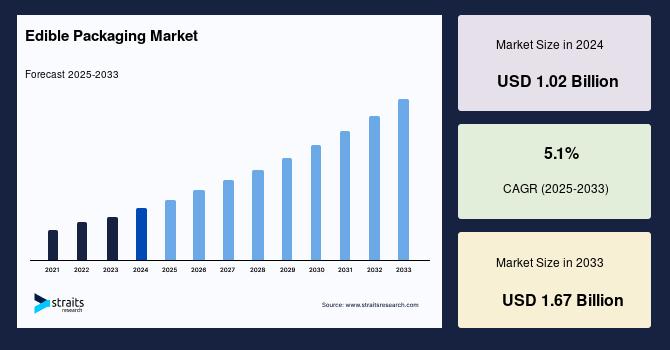Introduction
The global edible packaging market is experiencing significant growth, driven by increasing environmental concerns and the need for sustainable alternatives to traditional packaging materials. Edible packaging refers to materials made from food-grade substances that can be safely consumed along with the product they contain. These innovative solutions aim to reduce plastic waste, enhance food preservation, and align with the growing consumer demand for eco-friendly products.
Market Overview
According to Straits Research, the global edible packaging market was valued at USD 1.02 billion in 2024 and is projected to reach USD 1.67 billion by 2033, growing at a CAGR of 5.1% during the forecast period (2025–2033).
Market Drivers
1. Environmental Concerns
The increasing awareness of environmental issues, particularly plastic pollution, has led to a shift towards sustainable packaging solutions. Edible packaging offers a biodegradable and compostable alternative to conventional plastic, reducing the environmental footprint of packaging materials.
2. Consumer Demand for Eco-Friendly Products
Consumers are becoming more conscious of the environmental impact of their purchasing decisions. The demand for products with minimal environmental impact is driving the adoption of edible packaging solutions in the food industry.
3. Regulatory Support
Governments worldwide are implementing regulations to reduce plastic waste and promote sustainable practices. Policies such as plastic bans and incentives for using biodegradable materials are encouraging the development and adoption of edible packaging solutions.
Market Challenges
1. Consumer Acceptance
Despite the environmental benefits, some consumers may be hesitant to embrace edible packaging due to unfamiliarity or concerns about hygiene and safety. Educating consumers about the advantages and safety of edible packaging is essential for widespread adoption.
2. Technological Limitations
The development of edible packaging materials that meet the required standards for strength, shelf-life, and food safety is a complex process. Ongoing research and innovation are necessary to overcome these technological challenges.
3. Cost Considerations
The production of edible packaging materials can be more expensive than traditional packaging options. Balancing cost with sustainability is a key challenge for manufacturers in the edible packaging market.
Market Segmentation
By Material Type
-
Proteins: Derived from sources like whey, soy, and casein, protein-based edible packaging materials offer strength and flexibility.
-
Polysaccharides: Materials such as starch, cellulose, and chitosan provide structural integrity and are commonly used in edible films and coatings.
-
Lipids: Fat-based materials can create water-resistant barriers, extending the shelf life of food products.
By End-Use Industry
-
Food and Beverages: The largest segment, driven by the demand for sustainable packaging solutions in food products.
-
Pharmaceuticals: Edible packaging materials are used in drug delivery systems, offering controlled release and improved patient compliance.
-
Cosmetics: The use of edible packaging in cosmetics is emerging, focusing on natural ingredients and sustainable packaging options.
By Application
-
Films and Coatings: Thin layers applied to food products to provide a protective barrier and extend shelf life.
-
Edible Straws and Utensils: Single-use items made from edible materials, reducing plastic waste.
-
Capsules and Encapsulated Products: Used for controlled release of active ingredients in pharmaceuticals and functional foods.
Regional Analysis
-
North America: The largest market share is held by the North American region, driven by consumer demand for sustainable products and supportive regulatory frameworks
-
Europe: The fastest-growing market, with increasing adoption of edible packaging solutions in the food and pharmaceutical industries.
-
Asia-Pacific: Emerging markets with growing industrial sectors and increasing awareness of environmental issues.
-
Middle East & Africa: Developing markets with potential for growth in the edible packaging sector.
-
Latin America: Developing markets with increasing infrastructure projects and awareness of sustainability issues.
Future Outlook
The edible packaging market is poised for continued growth, driven by technological advancements, increasing consumer demand for sustainable products, and supportive regulatory environments. Innovations in material science and packaging technologies will further enhance the functionality and appeal of edible packaging solutions.
Conclusion
The global edible packaging market is experiencing significant growth, fueled by environmental concerns, consumer demand for sustainable products, and regulatory support. As the food, pharmaceutical, and cosmetic industries continue to seek eco-friendly alternatives, edible packaging offers a promising solution to reduce plastic waste and enhance product sustainability. Ongoing research and innovation will play a crucial role in overcoming existing challenges and unlocking the full potential of edible packaging in various applications.

